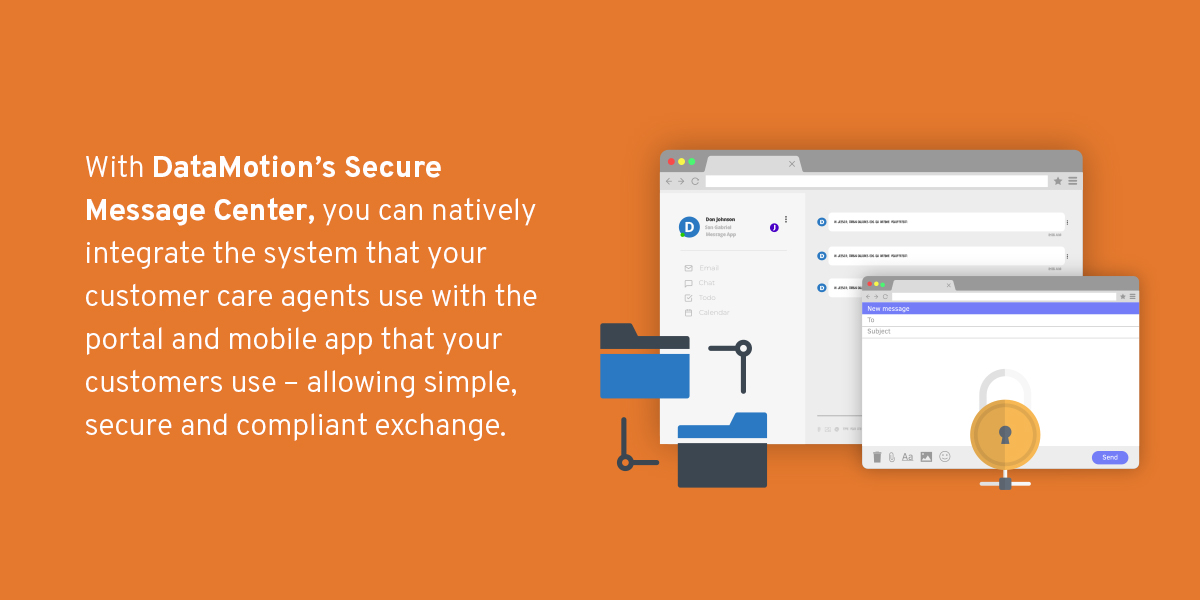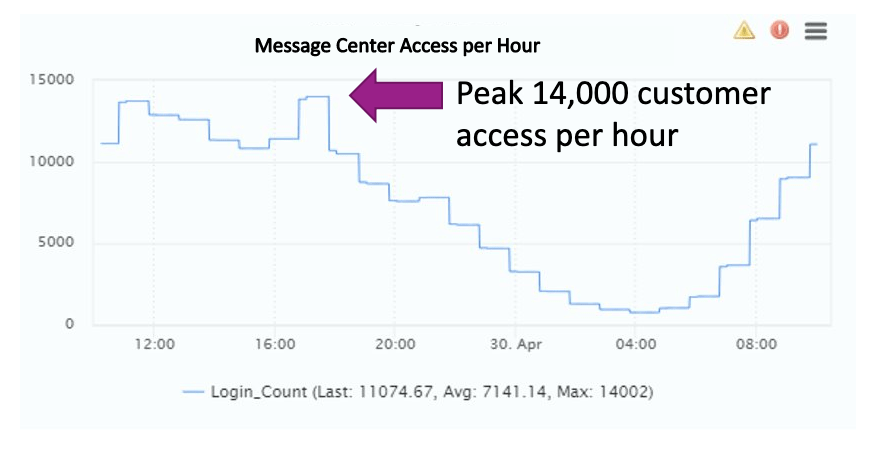In previous blogs, we’ve touched upon how using an omnichannel strategy is a great way to provide a better experience for your customers. We’ve also discussed that an integrated, secure email channel is missing in most omnichannel experiences. However, we’ve yet to really dive into the demands for omnichannel and the benefits of successfully implementing the strategy, or provide a real-life example of how a secure channel in your omnichannel strategy can elevate customer experience and make things easier for your organization.
We’ve all heard it before — putting all customer interactions in one place allows you to provide an excellent experience and makes your job easier. But do you know the omnichannel data that backs this up?

Introduction to Omnichannel Strategy
An effective introduction to omnichannel strategy begins with understanding its fundamental concept — the integration of multiple communication and distribution channels to provide customers with a seamless and consistent experience. Today’s consumers expect a unified and cohesive brand experience across various touchpoints, whether a physical store, website, mobile app, social media or even customer service. The success of an omnichannel strategy lies in breaking down silos between channels and departments to improve brand consistency, streamline operations and enhance customer satisfaction.
Benefits of a Secure Channel in an Omnichannel Strategy
Secure channels are integral to the success of an omnichannel strategy, offering a range of invaluable benefits. When customer information is protected, your company will enjoy better customer satisfaction and long-term success.
A secure channel’s significance lies in safeguarding customer trust, reputation, financial stability and legal compliance. With secure channels in your omnichannel strategy, you can use your omnichannel for heightened customer experience management.
Here are a few of the benefits you can expect when you use a secure channel:
- Improved data security: Secured channels help protect sensitive customer data, which is essential to building and maintaining customer trust.
- Improved regulatory compliance: Many locations have strict data privacy regulations — one example is the California Consumer Privacy Act. Secured channels help businesses comply with these regulations.
- Customer trust: Security breaches can severely erode customers’ trust in the business’s ability to keep their sensitive data safe. This lack of trust can severely damage a company’s reputation and loss of business.
- Fraud prevention: Secured channels are essential to preventing fraudulent activities, such as identity theft or unauthorized transactions.
- Competitive advantage: Customers are more likely to choose a business that they trust with their data.
- Unified customer experience: Your customers will enjoy a seamless experience across multiple channels, resulting in improved satisfaction and retention.
Examples of Secure Channels
Secure channels encompass a variety of technologies and practices that safeguard data and communications for your company and customers. Here are some secure channel examples you might invest in:
- Encryption: Use encryption protocols like SSL/TLS for web traffic, end-to-end encryption for messaging apps or data-at-rest encryption to protect stored data. DataMotion offers secure digital engagement solutions, including secure messaging, secure forms, and secure document exchange, that allow for secure communication between your business and its customers.
- Virtual private networks (VPNs): VPNs establish encrypted tunnels over public networks, ensuring secure and private data transmission for remote access.
- Multi-factor authentication (MFA): MFA requires users to provide multiple forms of verification — passwords, biometrics or tokens — before granting access, enhancing security significantly.
- Secure Sockets Layer (SSL) certificates: SSL certificates validate website authenticity, ensuring users connect to legitimate and secure web platforms.
- Firewalls: Network firewalls filter incoming and outgoing traffic, protecting against unauthorized access and potential threats.
- Secure messaging platforms: Messaging apps with end-to-end encryption, like DataMotion’s secure message center, keep conversations private.
- Tokenization: Replacing sensitive data with non-sensitive tokens reduces the risk of exposing valuable information.
- Secure cloud storage: Cloud providers with robust security measures, such as encryption at rest and in transit, safeguard data stored in the cloud.
Balancing Convenience and Security for Regulated Industries
Providing an excellent and secure omnichannel customer experience in financial services and other regulated industries is equally important as in retail or e-commerce spaces.
In fact, DataMotion conducted a survey to hear what IT and Financial Services Executives have to say about their own company and their customer communications. Almost half complained about inefficient workflows involving fax and postal mail. They also expressed complaints over limited ways to interact with their customers while maintaining regulatory compliance and the multiple user IDs needed to access their legacy methods of secure document exchange or email encryption. Unsurprisingly, this survey also revealed a desire to see all interactions with their customers in a unified interface.
The push for an omnichannel strategy and seamless interactions in regulated industries has only grown since this survey. If not just because of social distancing and the coronavirus halting face-to-face business and pushing for all interactions to take place digitally, but also because of the generational shift and increasing influence of Millennials and Generation Z.
These generations don’t just want businesses to be “digital-first” — they prefer to do business with vendors whose digital experience is polished and slick. If they have a problem with a transaction, a question about their bank statement or something else, they expect to be able to easily exchange messages and supporting documents digitally in their customer app to get their questions answered. If their problem-resolution experience is difficult, time-consuming or requires too many steps, consumers from these generations especially will not hesitate to take their business elsewhere.
Investing in secure channels for your omnichannel strategy allows your business to maximize convenience for customers and staff while safeguarding sensitive data. You will gain a competitive advantage, and bring a superior experience for all.

Ensuring a Secure, Frictionless Customer Experience
So, tying this all back to omnichannel, how can we meet these demands for a frictionless, digital-first customer experience without sacrificing security and compliance for those in regulated industries? We need to make the customer app or portal part of this omnichannel strategy and allow simplified and secure exchanges of sensitive information between your customers and internal customer service agents.
This experience needs to be native in the app. Your customers shouldn’t have to receive a secure email from their bank, and then be taken outside of your app to some other portal to access it. Why is this? Because your employees, and especially your customers, do not want to deal with any extra logins or portals – they should be able to send, receive, and review messages and documents, even those containing sensitive data, in a seamless and natural way.
How can we accomplish this? By using application programming interfaces (APIs) to integrate a messaging center behind the login of an organization’s application, customer portal, or mobile app, we can allow all of these interactions to occur in one place. With DataMotion’s secure message center, you can natively integrate the system that your customer care agents use with the portal and mobile app that your customers use – allowing simple, secure and compliant exchange. Your agents and customers can then easily initiate, retrieve and review sensitive exchanges from within the interface they’re already using.
A Real-Life Example of an Omnichannel Strategy in a Regulated Industry
Instead of diving into the details of how a secure message center can fit into your omnichannel strategy, what it is, and how it works, it would be better to provide you with a real-life example.
Below is an actual graph of an integrated message center in use by a large wealth management firm with over 2 million customers. They actively use our secure message center, peaking at about 100 API calls per second. On the left-hand side of this graph, you can see that they reach about 750 new messages or documents per hour. These are messages that are exchanged between the organization from their internal support systems and customers that are logged in to their customer app.


Over time, individual customer repositories or message folders continue to grow with exchanged messages and documents. This turns a customer’s message center into a personalized knowledge base of their relationship with the organization. In fact, on the right-hand side of the graph, you can see message center access peak at 14,000 per hour. So, for these 750 message exchanges per hour, customers are referring to prior exchanges over 18 times to 1 over sending a new message. They’re often able to find the answer they need in a prior exchange before asking a new question.
There are also other benefits of implementing this secure message and document exchange, which cannot be seen in the above graph. First, this organization’s customers are using the message center twice as much as they were the year before. Despite this increase in usage, the number of support requests that the organization now receives from its 2+ million customers has dropped by 30%. Not only that, but since the beginning of the year, the average size of messages has tripled, indicating that more documents are being attached and exchanged digitally.
So, as the usage of this private message channel grows, the repository of prior exchanges grows, and the customer’s relationship with the organization grows as well. This is because their customers rely on and trust this channel to get answers to their questions – it becomes a familiar touchpoint to them. Not only does secure message center allow this organization to provide a superior customer experience, but this knowledge base aspect has also allowed them to increase the retention of their customers as well.
In Summary
Let’s summarize the key points we covered in this blog:
- Implementing an omnichannel strategy is important for improving your customers’ experience and helping you retain customers in the long run.
- Customers are demanding efficient, secure and frictionless experiences with the organizations that they do business with, including those in regulated industries.
- Secure exchange in your customer app or portal helps you provide a superior customer experience and allows you to make your agents’ job easier, create a personalized knowledge base of information for your customers, and improve customer retention.
Transform Your Omnichannel Strategy with DataMotion’s Secure Message Center
Invest in quality and compliant omnichannel security with DataMotion’s secure message center. Our state-of-the-art platform ensures your sensitive customer data remains confidential and protected across all communication channels. Whether you’re engaging with customers through email, websites, mobile apps or messaging apps, our secure message center guarantees end-to-end encryption and robust security measures.
By choosing DataMotion, you’ll enhance your omnichannel interactions’ security and build lasting trust with your customers. Don’t compromise on data security — take the proactive step to safeguard your omnichannel strategy. Put your data in safe hands by contacting us today.
Updated November 1, 2023
Are you interested in adding a secure channel to your omnichannel strategy?
Learn more about our secure message center to get started today!


